PET bottle recycling
Bottles made of polyethylene terephthalate (PET, sometimes PETE) can be recycled and used to manufacture new bottles and containers, thermoform packaging, strapping and are also used in fiber applications such as carpet and apparel. In many countries, PET plastics are coded with the resin identification code number "1" inside the universal recycling symbol, usually located on the bottom of the container. The National Association for PET Container Resources (NAPCOR) defines PET as: "Polyethylene terephthalate items referenced are derived from terephthalic acid (or dimethyl terephthalate) and mono ethylene glycol, wherein the sum of terephthalic acid (or dimethyl terephthalate) and mono ethylene glycol reacted constitutes at least 90 percent of the mass of monomer reacted to form the polymer, and must exhibit a melting peak temperature between 225°C and 255°C, as identified during the second thermal scan in procedure 10.1 in ASTM D3418, when heating the sample at a rate of 10°C/minute."[1]
Usage of PET
PET is used as a raw material for making packaging materials such as bottles and containers for packaging a wide range of food products and other consumer goods. Examples include carbonated soft drinks, alcoholic beverages, detergents, cosmetics, produce, pharmaceutical products and edible oils. PET is one of the most common consumer plastics used and highly recyclable.,[2][3]
Polyethylene terephthalate can also be used as the main material in making water-resistant paper.[4]
Process

Post-consumer waste
The empty PET packaging is discarded by the consumer, after use and becomes PET waste. In the recycling industry, this is referred to as "post-consumer PET." Many local governments and waste collection agencies have started to collect post-consumer PET separately from other household waste. Besides that there is container deposit legislation in some countries which also applies to PET bottles.
It is debatable whether exporting circulating resources that damages the domestic recycling industry is acceptable or not.[6] In Japan, overseas market pressure led to a significant cost reduction in the domestic market. The cost of the plastics other than PET bottles remained high.
In the United States, there are two primary methods for recovery of PET bottles and containers. The first is curbside recycling to which most consumers have access. The waste hauler brings the recycled material to a material recovery facilities (MRFs) where it is further separated. The PET is then baled and sent on to a PET reclaimer. The PET reclaimer processes the bale, grinding the PET into flakes. Some do additional processing to make ready for food grade packaging. A link to the video of the process may be found here - PET Recovery Video.
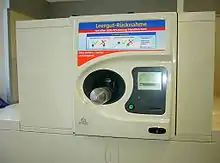 |
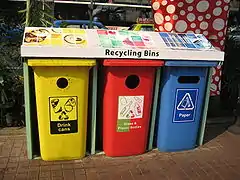 Recycling bins usually include one for glass and/or plastic bottles, such as Urban Environmental Management and Technology in Singapore. |
Sorting
When the PET bottles are returned to an authorized redemption center, or to the original seller in some jurisdictions, the deposit is partly or fully refunded to the redeemer. In both cases the collected post-consumer PET is taken to recycling centres known as materials recovery facilities (MRF) where it is sorted and separated from other materials such as metal, objects made out of other rigid plastics such as PVC, HDPE, polypropylene, flexible plastics such as those used for bags (generally low density polyethylene), drink cartons, glass, and anything else which is not made out of PET.
Post-consumer PET is often sorted into different colour fractions: transparent or uncoloured PET, blue and green coloured PET, and the remainder into a mixed colours fraction. The emergence of new colours (such as amber for plastic beer bottles) further complicates the sorting process for the recycling industry.
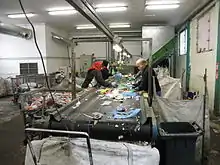 PET bottles are separated from other plastics in a materials recovery facility. |
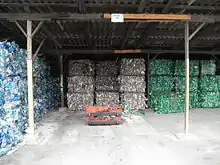 Bales of crushed PET bottles sorted according to color: blue, transparent, and green. |
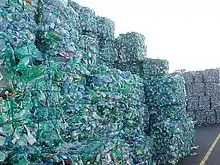 Bales of crushed PET bottles. |
Processing for sale
The sorted post-consumer PET waste is crushed, pressed into bales and offered for sale to recycling companies. Colourless/light blue post-consumer PET attracts higher sales prices than the darker blue and green fractions. The mixed color fraction is the least valuable due simply to the fact unlike aluminium, there are few standards when it comes to the coloration of PET. Unlike clear varieties, PET with unique color characteristics are only useful to the particular manufacturer that uses that color.[7] For material recovery facilities, colored PET bottles are therefore a cause for concern as they can impact the financial viability of recycling such materials. The Plastics Recyclers Europe (PRE, Brussels, Belgium), that an upsurge in a variety of PET colors would be a problem because no market exists for them in the current recycling climate.[8]
Further treatment
The further treatment process includes crushing, washing, separating and drying. Recycling companies further treat the post-consumer PET by shredding the material into small fragments. These fragments still contain residues of the original content, shredded paper labels and plastic caps. These are removed by plastic granulation, resulting in pure PET fragments, or "PET flakes". PET flakes are used as the raw material for a range of products that would otherwise be made of polyester. Examples include polyester fibres (a base material for the production of clothing, pillows, carpets, etc.), polyester sheets, strapping, or back into PET bottles.
Melt filtration
Melt filtration is typically used to remove contaminants from polymer melts during the extrusion process.[9] There is a mechanical separation of the contaminants within a machine called a ‘screen changer’. A typical system will consist of a steel housing with the filtration medium contained in moveable pistons or slide plates that enable the processor to remove the screens from the extruder flow without stopping production. The contaminants are usually collected on woven wire screens which are supported on a stainless steel plate called a ‘breaker plate’—a strong circular piece of steel drilled with large holes to allow the flow of the polymer melt. For the recycling of polyester it is typical to integrate a screen changer into the extrusion line. This can be in a pelletizing, sheet extrusion or strapping tape extrusion line.
Drying polyester
PET polymer is very sensitive to hydrolytic degradation, resulting in severe reduction in its molecular weight, thereby adversely affecting its subsequent melt processability. Therefore, it is essential to dry the PET flakes or granules to a very low moisture level prior to melt extrusion.
PET must be dried to <100 parts per million (ppm) moisture and maintained at this moisture level to minimize hydrolysis during melt processing.[10]
Dehumidifying Drying - These types of dryers circulate hot and de-humidified dry air onto the resin, suck the air back, dry it and then pump again in a closed loop operation. This process reduces moisture level in the PET down to 50ppm or lower. The efficiency of moisture removal depends on the air dew point. If the air dew point is not good, then some moisture remains in the chips and cause IV loss during processing.
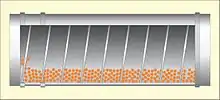
Infrared Drying polyester pellets and flakes - A new type of dryer has been introduced in recent years, using Infrared drying (IRD). Due to the high rate of energy transfer with IR heating in combination with the specific wavelength used, the energy costs involved with these systems can be greatly reduced, along with the size. Polyester can be dried and amorphous flake crystallized and dried within only about 15 minutes down to a moisture level of approx. 300ppm in one step, and down to <50 ppm using a buffer hopper to complete the drying in typically under 1 hour
Global statistics

Worldwide, approximately 7.5 million tons of PET were collected in 2011. This gave 5.9 million tons of flake. In 2009 3.4 million tons were used to produce fibre, 500,000 tons to produce bottles, 500,000 tons to produce APET sheet for thermoforming, 200,000 tons to produce strapping tape and 100,000 tons for miscellaneous applications.[11]
Petcore, the European trade association that fosters the collection and recycling of PET, reported that in Europe alone, 1.6 million tonnes of PET bottles were collected in 2011 - more than 51% of all bottles. After exported bales were taken into account, 1.12 million tons of PET flake were produced. 440,000 tons were used to produce fibres, 283,000 tons to produce more bottles, 278,000 tons to produce APET sheets, 102,000 tons for strapping tape and 18,000 tons for miscellaneous applications. (Source: PCI for Petcore and EuPR)
In 2008 the amount of post-consumer PET bottles collected for recycling and sold in the United States was approx. 1.45 billion pounds.[12]
In 2012, 81% of the PET bottles sold in Switzerland were recycled.[13]
In 2018, 90% of the PET bottles sold in Finland were recycled. The high rate of recycling is mostly result of the deposit system in use. The law demands a tax of 0,51 €/l for bottles and cans that are not part of a refund system. Thus encouraged by the law, products are included to have a 10¢ to 40¢ deposit that is paid to the recycler of the can or bottle.[14]
Increasing energy prices may increase the volume of recycling PET bottles.[12] In Europe, the EU Waste Framework Directive mandates that by 2020 there should be 50% recycling or reuse of plastics from household streams.[12]
In the United States the recycling rate for PET packaging was 31.2% in 2013, according to a report from The National Association for PET Container Resources (NAPCOR) and The Association of Postconsumer Plastic Recyclers (APR). A total of 1,798 million pounds was collected and 475 million pounds of recycled PET used out of a total of 5,764 million pounds of PET bottles.[15]
PET bottles recycle-rate globally[16][17]
| Japan | US | Europe | India [18] |
|---|---|---|---|
| 72% | 29% | 48% | 90% |
Re-use of PET bottles
PET bottles are also repurposed for various uses, including for use in school projects, and for use in solar water disinfection in developing nations, in which empty PET bottles are filled with water and left in the sun to allow disinfection by ultraviolet radiation. PET is useful for this purpose because many other materials (including window glass) that are transparent to visible light are opaque to ultraviolet radiation.[19]
A novel use is as a building material in third-world countries. According to online sources, the bottles, in a labor-intensive process, are filled with sand, then stacked and either mudded or cemented together to form a wall. Some of the bottles can be filled instead with air or water, to admit light into the structure.
See also
References
- "What is PET? - NAPCOR". NAPCOR. Retrieved 2020-07-08.
- Clark Howard, Brian. "Recycling Symbols on Plastics - What Do Recycling Codes on Plastics Mean". The Daily Green (Good Housekeeping). Retrieved May 7, 2012.
- Chacon, F A (January 2020), "Effect of recycled content and rPET quality on the properties of PET bottles, part I: Optical and mechanical properties", Packaging Technology and Science, 33 (9): 347–357, retrieved 12 September 2020
- Teijin. "Teijin Develops Eco-friendly Wet-strong Printing Paper Made 100% with Recycled Polyester Derived from Used PET Bottles". Teijin Group. Archived from the original on August 25, 2013. Retrieved March 12, 2013.
- "Plastic Packaging Resins" (PDF). American Chemistry Council. Archived from the original (PDF) on 2011-07-21.
- K. Hanaki: Urban Environmental Management and Technology, ISBN 9784431783978, p. 104
- read, Tom Szaky Published 5 years ago About a 6 minute (April 22, 2015). "The Many Challenges of Plastic Recycling". Sustainable Brands.
- "Colored PET: Pretty To Look At; Headache For Recyclers". www.ptonline.com.
- Melt Filtration Options and Alternatives Archived 2011-09-28 at the Wayback Machine
- http://infohouse.p2ric.org/ref/14/13543.pdf PET Drying Best Practices
- "- PCI Wood Mackenzie". PCI Wood Mackenzie. Retrieved 2017-07-01.
- Nicholas Dege: The Technology of bottled water, p. 431, John Wiley & Sons, 2011, ISBN 9781444393323
- http://www.bafu.admin.ch/dokumentation/medieninformation/00962/index.html?lang=fr&msg-id=50084 (page visited on 4 November 2013).
- "Deposit refund system". www.palpa.fi.
- Caliendo, Heather (8 October 2014). "Recycling for PET packaging reaches 31 percent in 2013". PlasticsToday. Retrieved 20 December 2018.
- Japan streets ahead in global plastic recycling race Primary source is 『Plastic Waste Management Institute, Tokyo http://www.pwmi.or.jp/ei/index.htm』
- "Global Plastic Bottle Recycling Market-Industry Analysis and Forecast (2020-2027)". FREE UK Press Release Distribution. Retrieved 2020-12-21.
- http://www.hindustantimes.com/mumbai-news/india-recycles-90-of-its-pet-waste-outperforms-japan-europe-and-us-study/story-yqphS1w2GdlwMYPgPtyb2L.html NCL and PET Packaging Association for Clean Environment (PACE) Data release Feb 2017. The figure is strikingly high and could place India as among the top recycles of PET. The reason is thought not to be due to a strong recycling culture or infrastructure at the consumer end, but by ragpickers who collect and sell the bottles discarded as normal trash to reprocessors. The industry is supposed to be a ₹3200 crore one>
- Spuhler, Dorothee; Meierhofer, Regula. "SODIS". Sustainable Sanitation and Water Management. Seecon. Retrieved 12 July 2017.
